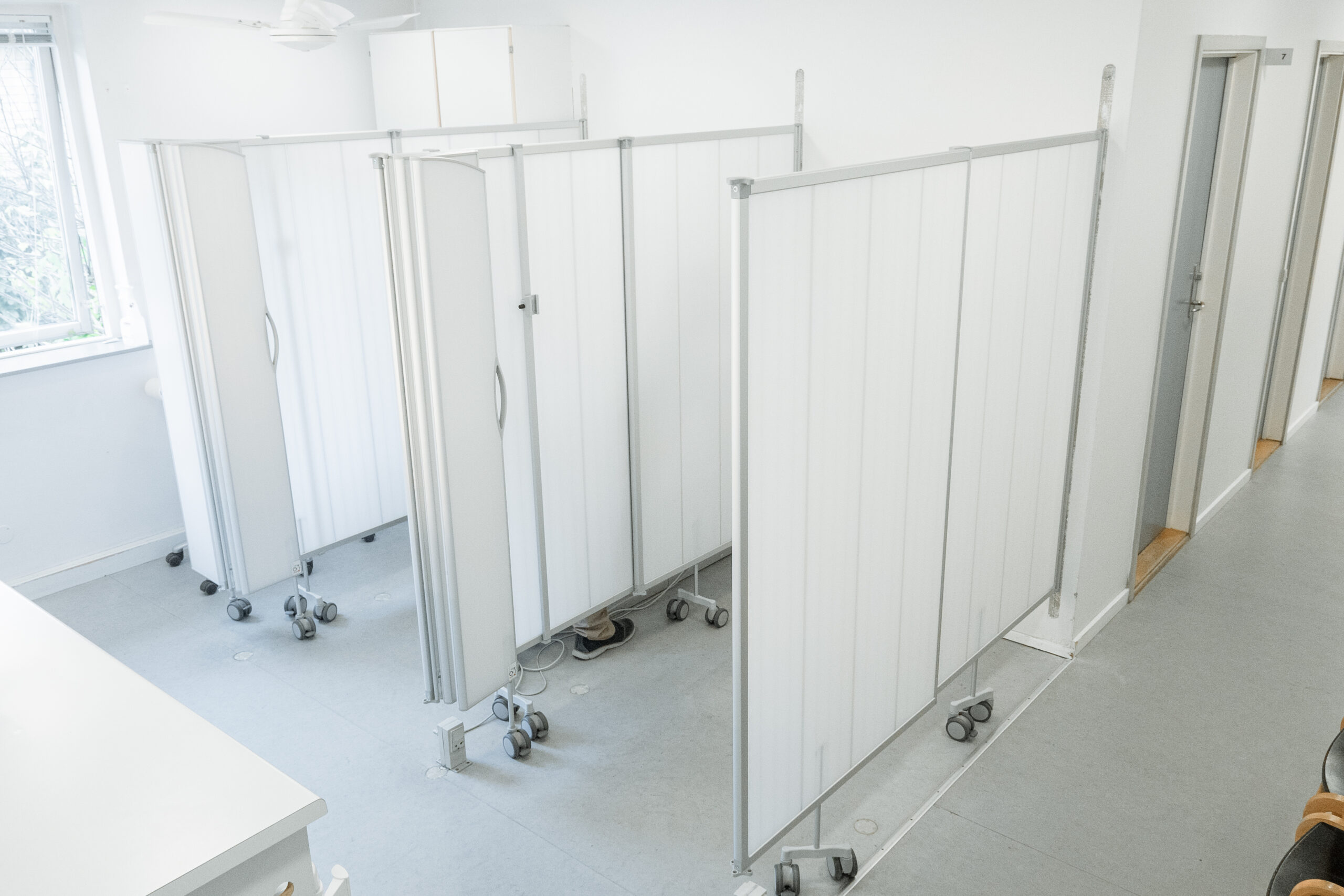
Bispebjerg Hospital in Copenhagen replaced 260 disposable curtains between patient beds with a more hygienic and eco-friendly alternative from Silentia. It took six weeks from initial contact to complete the installation, and the modularity of the screens means they can be transferred to new hospital buildings in the future.
For Iben Tousgaard, a nursing consultant in the Quality and Training Unit, replacing the disposable curtains in Bispebjerg Hospital’s patient rooms with Silentia screens was an easy decision.
Tousgaard sits on the hospital’s environmental committee, which is constantly on the lookout for measures that might help the Capital Region of Denmark achieve its ambitious 2030 climate targets, with the goal of reducing CO2 emissions by 50% compared to 2022.
“We work on the basis of a ‘stairway to sustainability’ consisting of three steps: we must use less, use things for longer, and use them in a more eco-friendly way. With a service life of at least 10 years, the Silentia screens are a perfect fit for step two, as they can be used for longer compared to disposable curtains,” she says.




CO2 savings – ”The icing on the cake”
Iben Tousgaard has previous experience with the Silentia screens and knew she could vouch for both their quality and hygiene benefits over disposable curtains, which are typically only changed every three months and can become contaminated with bacteria as a result.
“Quality and hygiene are decisive factors in opting for Silentia, and the CO2 savings were the icing on the cake. We prefer to invest in sustainable solutions, and these screens can last for many years and be transferred to our new hospital. They are also manufactured locally in the Nordic region, so there are quite a few climate-related details at play here,” says Iben Tousgaard.
Tousgaard also highlights their aesthetic benefits, which contribute to social sustainability at the hospital.
“The screens are a lot more pleasing to the eye than the disposable curtains, and, unlike the latter, daylight can penetrate over the top of the screens, which is beneficial for the patients. Equally, a member of staff does not have to take a stepladder into the room to change the curtains – so we avoid inconvenience to patients and staff alike,” she explains.




Payback in three years
Silentia’s calculations show that payback for the screens is achieved in three years when compared to the price of disposable curtains and the staff costs associated with changing them.
Naturally, the financial aspect plays a key role for Bispebjerg Hospital. The procurement of 260 screens in a single purchase means that a large part of its ongoing operating costs has been replaced by a one-off investment. This one-time investment can last for many years and be transferred over when the New Hospital Bispebjerg opens.
Even if the patient rooms in the new hospital are configured differently from those of the old buildings, the screens can be easily moved.
“Silentia’s modular system is really smart. We may well have a different setup in the new patient rooms, but the screens remain the same, and that was important for us,” says Jesper Krogstrup, Unit Head of Organisational Development at the New Hospital Bispebjerg and in charge of area and capacity planning for the hospital.




Six weeks from initial idea to completed installation
Jesper Krogstrup’s role in purchasing the screens was to ensure they represented a long-term solution and to take care of the logistics involved in implementing them in the current buildings.
“It was a very quick process, where we offered to pay for the screens centrally. Together with two members of Silentia’s staff, Iben and I visited every clinical unit. At the units, the charge nurses could say whether they were interested, and Silentia then came up with a proposed solution,” he explains.
It then took around two weeks until the order entered production, and four weeks later, the Silentia team had finished installing the 260 screens.
“It took no more than a week for the Silentia team to install all the screens. Only a few unresolved issues remained, such as patient rooms that were off limits because patients were in isolation and other minor matters that required special attention. It was managed very efficiently,” says Jesper Krogstrup.
Before installation was complete, some of the wards had changed their minds, one way or another, and here too the modular system proved its worth.
“It was only a matter of changing the fittings, and, in any case, we actually ended up increasing the order quantity,” he says.

Scalable solution with clear benefits
Silentia’s screens are easily wiped down and disinfected as part of the daily cleaning routine. This is very different from the disposable curtains, which can become contaminated within a day and then often remain in place for months at a time.
“Hygiene and sustainability were the most important factors in opting for Silentia’s solution. But it also has the advantage of being a scalable solution that we can add to or modify in situ in the patient rooms. And even if the dimensions are different in the new buildings, we are completely confident that we can enjoy the benefits of the screens for many years to come,” says Jesper Krogstrup.
Bispebjerg Hospital has adopted a solution that is both more hygienic and more eco-friendly while also expected to significantly reduce costs over the screens’ long service life. To learn more about our resource-efficient privacy solutions and how to implement them in your facility, connect with our team of experts.
A big thank you from everyone at Silentia to Jesper, Iben, and all of Bispebjerg Hospital for a fantastic collaboration!


